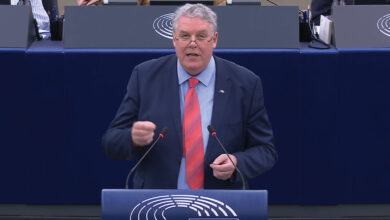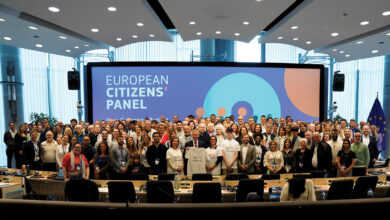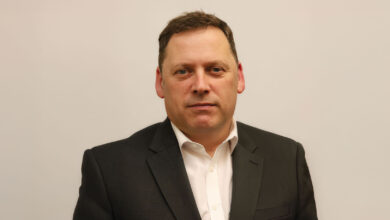EU electricity market reform
 Eurelectric markets adviser Charlotte Renaud examines the role of European electricity market reform in achieving a low carbon economy.
Eurelectric markets adviser Charlotte Renaud examines the role of European electricity market reform in achieving a low carbon economy.
Charlotte Renaud is keen to highlight the European perspective on integrating electricity markets, particularly in the context of the EU target model. The current focus is on reviewing market design and introducing capacity limits. Eurelectric wants to see a cost-effective EU energy and climate policy which will achieve carbon neutrality by 2050.
The 2014 implementation target of the integrated electricity market was missed due to delays in finalising network codes and problems with implementation in individual member states. Renaud contends that “even if sustainable progress has been made, there is still a lot of progress to be made in many areas.” The Agency for the Cooperation of Energy Regulators (ACER) and the electricity advisory groups are the foundation of the integration process, which needs a mix of bottom-up and top-down approaches.
The cornerstone to the development of all markets is a fully integrated European energy market. Renaud remarks that integration “would optimise the use of assets across the whole of Europe, thus leading to more efficient market participation by all agents, and ultimately to a more cost-efficient delivery of energy to our customers.”
She adds: “We need more interconnection between national markets as well as the removal of any market distortions on wholesale and retail markets, such as regulated prices in retail markets or price gaps in wholesale markets.”
Progress has been made towards a single pan-European day-ahead market through a price coupling solution. This aims to lower average prices across the EU by synchronising the day-ahead operations of different markets in terms of gate closure times, available products and transmission capacity allocation across borders.
Renaud considers price coupling to be an important step in extending the EU area, and uses the example of the North Western Europe (NWE) pilot project which went live in February 2014, covering 75 per cent of the EU electricity market. The South Western Europe (SWE) region was also successfully coupled with the NWE region in May 2014, and the Central Eastern area was coupled in November 2014.
However, market coupling is only the first step. Intra-day markets are crucial to bridging gaps between markets. TSOs and power exchanges have faced several technical and organisational difficulties in achieving this and the lack of a clear timeline is also a problem. The XBID solution, which is based on a common IT system and aims to create an integrated EU intra-day market, is planned for July 2015 but realistically it will not be completed until 2017. Renaud stresses the importance of using a common trading platform.
Progress is also needed in balancing and in the ancillary services markets. Ensuring a continuous balance of demand and supply at the lowest possible cost to customers is key. Greater integration and co-ordination of electricity balancing rules should increase cross-border trading, thus reducing costs and increasing the security of supply. The top-down approach of achieving this is through Electricity Balancing Network Code guidelines. The bottom-up approach includes several regional pilot projects.
Challenges
Renaud outlines the challenges facing the single European electricity market i.e. there is a large gap between the target model and existing initiatives, and large differences between different national models.
The network codes and guidelines are currently being drawn up. Most codes have now been passed by ACER and are awaiting approval by the Commission. Only one code has actually been adopted by member states so far, with the aim for all codes to be finalised by the end of the year. Renaud says the codes should be implemented in a timely manner at national and EU levels with the involvement of stakeholders.
Voluntary co-operation in bringing forward these changes should be fostered, and moved forward by ACER if it stalls. Long-term market rules should be set for intra-day and capacity calculation. Common rules should also be set down for system security, assessing adequacy, planning outages and emergencies.
Renaud remarks: “Europe is moving to a low carbon electricity system. The growth of intermittent renewables, which is necessary to the decarbonisation agenda, brings a completely new reality to our power systems.” She adds: “Many markets today face a paradox. We need the back-up capacity to secure the electricity supply to customers but often current market designs do not provide the right incentives to ensure the capacity is present.”
Capacity is becoming increasingly important due to growing uncertainty about security of supply. The necessary growth of renewables to decarbonise the power sector should be developed through integrated electricity markets, whilst keeping costs down and guaranteeing that customers’ lights stay on.
The energy ‘policy triangle’ is being challenged both in terms of competitiveness and security of supply. She adds: “Clearly the low carbon transition is more costly than it needs to be at the moment. Wholesale prices are stable, but it is households that are paying the price. We need to rethink the overall market design. Energy flexibility and capacity are elements that have to work together going forward. New market design should include flexibility elements to ensure optimisation of the market but also more capacity elements to ensure long-term sustainability.”
Renewable electricity support costs have escalated in some countries with inefficient or outdated design mechanisms. An increase in rising variable generation is displacing conventional generation which is needed for generation adequacy but is being forced to shut down due to economic factors.
The EU is so far on track to meet its emissions reductions and renewable targets up to 2020.
A cost-efficient, market-based transition towards decarbonisation includes “making renewables fit for the market and making the market fit for renewables.” Increasing capacity markets would have to be introduced carefully and there should be a market-based renewables support scheme. A strong emissions trading system is also a key driver for renewable electricity investments. Further subsidies should be avoided for mature renewable projects, while respecting existing contracts to support current renewables.
Renaud comments that emerging low carbon technologies need research, development and demonstration funding. The Commission will gather views on the new market design in June, which could then be followed by legislative proposals in 2016. In summary, Renaud believes there is “a good opportunity, if implemented correctly, to ensure a coherent and consistent implementation of EU energy policy in order to reach the 2030 targets in a cost-efficient way.”





